Related Research Articles

Giovanni di Niccolò de Luteri, better known as Dosso Dossi, was an Italian Renaissance painter who belonged to the School of Ferrara, painting in a style mainly influenced by Venetian painting, in particular Giorgione and early Titian.

Lorenzo Costa was an Italian painter.
Carlo Bononi was an Italian painter. An 1876 book lists him among "the last artists of any eminence in Ferrara".

The Bolognese school of painting, also known as the school of Bologna, flourished between the 16th and 17th centuries in Bologna, which rivalled Florence and Rome as the center of painting in Italy. Its most important representatives include the Carracci family, including Ludovico Carracci and his two cousins, the brothers Agostino and Annibale Carracci. Later, it included other Baroque painters: Domenichino and Lanfranco, active mostly in Rome, eventually Guercino and Guido Reni, and Accademia degli Incamminati in Bologna, which was run by Lodovico Carracci. Certain artistic conventions, which over time became traditionalist, had been developed in Rome during the first decades of the 16th century. As time passed, some artists sought new approaches to their work that no longer reflected only the Roman manner. The Carracci studio sought innovation or invention, seeking new ways to break away from traditional modes of painting while continuing to look for inspiration from their literary contemporaries; the studio formulated a style that was distinguished from the recognized manners of art in their time. This style was seen as both systematic and imitative, borrowing particular motifs from the past Roman schools of art and innovating a modernistic approach.

Scarsellino or Ippolito Scarsella was an Italian mid-to-late sixteenth century reformist painter and one of the most important representatives of the School of Ferrara. His landscapes of both sacred and secular themes strongly anticipate the landscape painting traditions of the 17th century.
Ludovico Mazzolino - also known as Mazzolini da Ferrara, Lodovico Ferraresa, and Il Ferrarese - was an Italian Renaissance painter active in Ferrara and Bologna.
Sebastiano Filippi was an Italian late Renaissance – Mannerist painter of the School of Ferrara.

Palazzo dei Diamanti is a Renaissance palace located on Corso Ercole I d'Este 21 in Ferrara, region of Emilia Romagna, Italy. The main floor of the Palace houses the Pinacoteca Nazionale di Ferrara.

Mantua Cathedral in Mantua, Lombardy, northern Italy, is a Roman Catholic cathedral dedicated to Saint Peter. It is the seat of the Bishop of Mantua.

Giuseppe Mazzuoli was an Italian painter of the Mannerist period, active mainly in the court of Alfonso II d'Este of Ferrara.
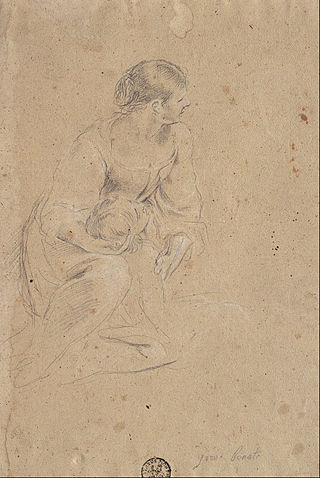
Giuseppe Bonati was an Italian painter of the Baroque period, active in Rome and Ferrara.
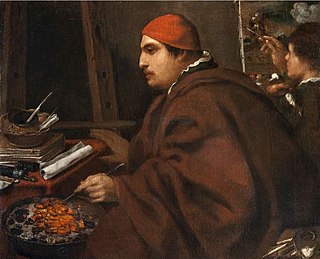
Giuseppe Caletti or Calletti was an Italian painter and engraver of the Baroque period, active in Ferrara and Cremona. He often painted religious themes in a genre like dress and surroundings, including the theme of Bacchanalia like Titian.

Giacomo Parolini was an Italian painter of the Baroque period, mainly active in Ferrara.
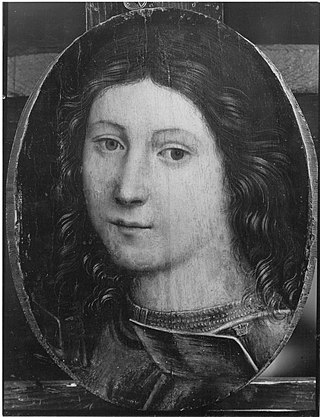
Ercole Grandi was an Italian painter of the early-Renaissance period, active mainly in Ferrara. Also known as Ercole da Ferrara and Ercole di Giulio Cesare Grandi, he has been claimed to be a favourite pupil of the painter Lorenzo Costa. Ercole Grandi first appeared in the historical record as being in the service of the house of Este in 1489. Between 1489 and 1495, Ercole Grandi seems to have been working in Bologna, both in San Petronio and in the Cappella Bentivoglio of San Giacomo Maggiore, as an assistant to Lorenzo Costa. In 1495, he was in Ferrara as the chief architect for realising Duke Ercole's plans to embellish the city and renovate the churches; the facade and interior of Santa Maria in Vado were executed from his design. He worked with Ludovico Mazzolino and others on the decoration of the Castello, and painted in the apartments of Lucretia Borgia. Also in Ferrara, he painted the frescoes for the church of San Pietro Martire, although some frescoes are preserved. One problem in assigning attribution to the hand of Ercole Grandi is that none of his works is signed or dated, or accompanied by supporting documents, but he is thought by some scholars to have painted—in the manner of Mantegna—or had a hand in, the decorative frescoed ceiling in the Sala del Tesoro of the Palazzo Costabili in Ferrara between 1503 and 1506. Other scholars attribute the work to Benvenuto Tisi da Garofalo. Confusingly, the identity of Ercole Grandi is sometimes conflated with Garofalo, and an Ercole da Bologna, and with that of Ercole di Antonio Roberti or Ercole de' Roberti, who was first documented as being in Ferrara in 1479, and was author of the great frescoes of the Garganelli chapel in Bologna. Most of Ercole Grandi's works have been reattributed to other Ferrarese painters, such as Giovan Francesco Maineri and Lorenzo Costa, while other scholars insist that Ercole Grandi is a mythical character.
Battista Dossi, also known as Battista de Luteri, was an Italian painter who belonged to the Ferrara School of Painting. He spent nearly his entire career in service of the Court of Ferrara, where he worked with his older brother Dosso Dossi. It is believed that Battista worked in the Rome studio of Raphael from 1517 to 1520. Battista's students include Camillo Filippi.

The Galleria Estense is an art gallery in the heart of Modena, centred around the collection of the d’Este family: rulers of Modena, Reggio and Ferrara from 1289 to 1796. Located on the top floor of the Palazzo dei Musei, on the St. Augustine square, the museum showcases a vast array of works ranging from fresco and oil painting to marble, polychrome and terracotta sculpture; musical instruments; numismatics; curios and decorative antiques.
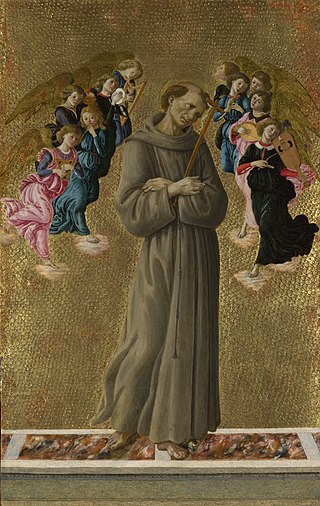
The Costabili collection or Costabili Gallery was a large art collection in Ferrara in the 19th century, mainly consisting of Ferrarese art. Works from the collection were purchased by mid and late 19th-century art collectors like Giovanni Morelli, Austen Henry Layard and Charles Eastlake, eventually ending in many of the major collections of art around the world. A significant group of paintings ended up in the National Gallery in London.
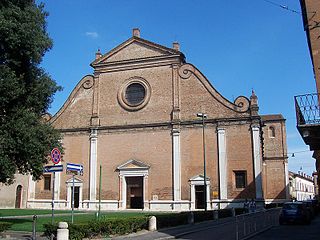
San Francesco is a late-Renaissance, Roman Catholic minor basilica church located on via Terranuova in Ferrara, Emilia-Romagna, Italy.

The Pinacotecta Nazionale is an art gallery in Ferrara, Emilia-Romagna, Italy. It is located on the piano nobile of the Palazzo dei Diamanti, a work of Renaissance architecture by Biagio Rossetti, commissioned by Leonello d’Este in 1447. Not to be confused with the Civic Museum on the lower floor, which has hosted temporary exhibitions of contemporary art since 1992, the Pinacoteca houses a collection of paintings by the Ferrarese School dating from the thirteenth to the eighteenth centuries. It was founded in 1836 by the Municipality of Ferrara after Napoleon's widespread dissolution of churches threatened the protection of important public artworks. The gallery is formed as much around notable northern Italian painters as it is around the exquisite interior decoration of the palace itself, together with remnants of frescoes from local churches and later acquisitions from the Sacrati Strozzi collection.

The Renaissance in Ferrara began with the signoria of Leonello d'Este around the mid-15th century. Under Leonello's patronage, Ferrara became a hub for the arts and intellectual thought, attracting prominent artists and scholars of the time. A significant contribution came from the Ferrarese school of painters, including Cosmè Tura, Francesco del Cossa, and Ercole de' Roberti. These artists were known for their innovative use of color, intricate detail, and emotive expressions, helping to define early Italian Renaissance art.
References
- Freedberg, Sydney J. (1993). Pelican History of Art (ed.). Painting in Italy, 1500–1600. Penguin Books Ltd.
- Francis P. Smyth and John P. O'Neill (1986). National Gallery of Art, Washington DC (ed.). The Age of Correggio and the Carracci: Emilian Painting of the 16th and 17th Centuries.
- Camillo Laderchi (1856). La pittura ferrarese, memorie. Googlebooks.